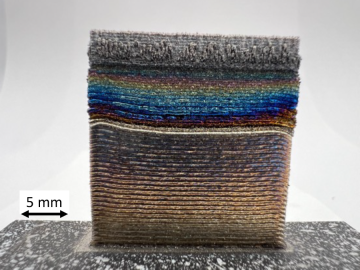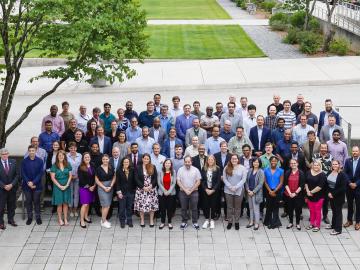
Filter News
Area of Research
- (-) Materials (433)
- (-) National Security (79)
- (-) Transportation Systems (11)
- Advanced Manufacturing (34)
- Biological Systems (18)
- Biology and Environment (177)
- Biology and Soft Matter (5)
- Building Technologies (12)
- Chemical and Engineering Materials (4)
- Chemistry and Physics at Interfaces (11)
- Clean Energy (522)
- Climate and Environmental Systems (14)
- Computational Biology (6)
- Computational Chemistry (5)
- Computational Engineering (5)
- Computer Science (19)
- Data (1)
- Earth Sciences (1)
- Electricity and Smart Grid (3)
- Energy Frontier Research Centers (14)
- Energy Sciences (5)
- Fossil Energy (3)
- Fuel Cycle Science and Technology (3)
- Functional Materials for Energy (16)
- Fusion and Fission (54)
- Fusion Energy (17)
- Geographic Information Science and Technology (3)
- Isotope Development and Production (3)
- Isotopes (35)
- Materials Characterization (2)
- Materials for Computing (36)
- Materials Synthesis from Atoms to Systems (13)
- Materials Under Extremes (12)
- Mathematics (1)
- Neutron Data Analysis and Visualization (4)
- Neutron Science (190)
- Nuclear Science and Technology (74)
- Nuclear Systems Modeling, Simulation and Validation (3)
- Nuclear Systems Technology (1)
- Quantum Condensed Matter (4)
- Quantum information Science (9)
- Reactor Technology (1)
- Renewable Energy (4)
- Sensors and Controls (5)
- Supercomputing (311)
News Type
News Topics
- 3-D Printing/Advanced Manufacturing (25)
- Advanced Reactors (5)
- Artificial Intelligence (21)
- Big Data (7)
- Bioenergy (14)
- Biology (8)
- Biomedical (8)
- Biotechnology (1)
- Buildings (6)
- Chemical Sciences (32)
- Clean Water (3)
- Climate Change (9)
- Composites (9)
- Computer Science (33)
- Coronavirus (6)
- Critical Materials (13)
- Cybersecurity (21)
- Decarbonization (10)
- Energy Storage (35)
- Environment (20)
- Exascale Computing (2)
- Frontier (3)
- Fusion (8)
- Grid (11)
- High-Performance Computing (8)
- Irradiation (1)
- Isotopes (13)
- ITER (1)
- Machine Learning (16)
- Materials (74)
- Materials Science (78)
- Mathematics (1)
- Microscopy (27)
- Molten Salt (3)
- Nanotechnology (39)
- National Security (34)
- Net Zero (1)
- Neutron Science (35)
- Nuclear Energy (21)
- Partnerships (14)
- Physics (29)
- Polymers (17)
- Quantum Computing (3)
- Quantum Science (12)
- Renewable Energy (1)
- Security (11)
- Simulation (2)
- Space Exploration (2)
- Summit (4)
- Sustainable Energy (16)
- Transformational Challenge Reactor (3)
- Transportation (17)
Media Contacts

Xiao-Ying Yu, a distinguished scientist at the Department of Energy’s Oak Ridge National Laboratory, has been named a Fellow of AVS: Science and Technology of Materials, Interfaces, and Processing, formerly American Vacuum Society.

When geoinformatics engineering researchers at the Department of Energy’s Oak Ridge National Laboratory wanted to better understand changes in land areas and points of interest around the world, they turned to the locals — their data, at least.

Research into a new, unique technology to fabricate composite metal parts for a wide range of applications operating in extreme environments across the aviation, space and energy industries is showing promise for additive manufacturing.

Experts across varied technology fields gathered ORNL to collaborate on the future of geospatial systems at the Trillion-Pixel GeoAI Challenge workshop. The third iteration of this event focused on multimodal advances in the field, including progress in artificial intelligence, cloud infrastructure, high-performance computing and remote sensing. These capabilities, when combined, can help solve problems in national and human security such as disaster response and land-use planning.

Researchers at the Department of Energy’s Oak Ridge National Laboratory were the first to use neutron reflectometry to peer inside a working solid-state battery and monitor its electrochemistry.

Tristen Mullins enjoys the hidden side of computers. As a signals processing engineer for ORNL, she tries to uncover information hidden in components used on the nation’s power grid — information that may be susceptible to cyberattacks.

Creating energy the way the sun and stars do — through nuclear fusion — is one of the grand challenges facing science and technology. What’s easy for the sun and its billions of relatives turns out to be particularly difficult on Earth.

Scientist-inventors from ORNL will present seven new technologies during the Technology Innovation Showcase on Friday, July 14, from 8 a.m.–4 p.m. at the Joint Institute for Computational Sciences on ORNL’s campus.

An advance in a topological insulator material — whose interior behaves like an electrical insulator but whose surface behaves like a conductor — could revolutionize the fields of next-generation electronics and quantum computing, according to scientists at ORNL.

Like most scientists, Chengping Chai is not content with the surface of things: He wants to probe beyond to learn what’s really going on. But in his case, he is literally building a map of the world beneath, using seismic and acoustic data that reveal when and where the earth moves.


